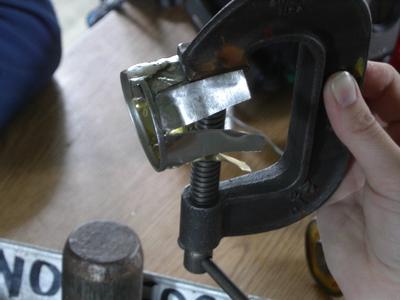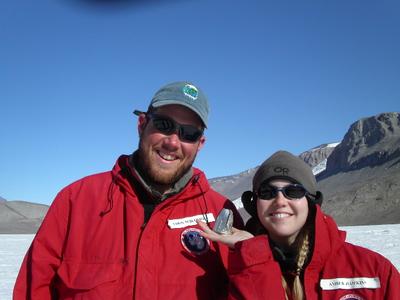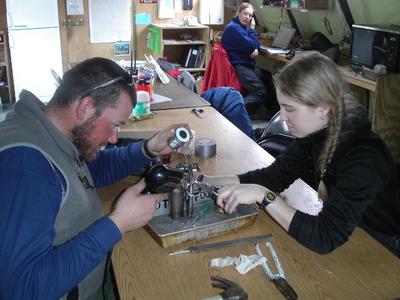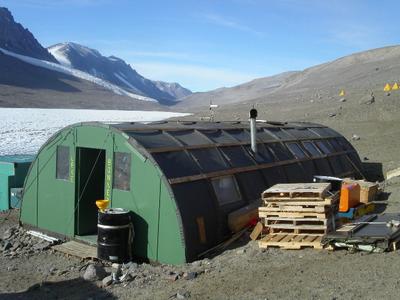
|
|
15 January, 2003
E-Mail Responses - A Continuation of Antarctic Information
I would again like to devote today's journal to answering some of the
questions I have received in my e-mails. This potpourri of Antarctic
information is in no parcticular order.
EVENINGS: After dinner we spend some time unwinding. Here at Bonney, we
have more space in the jamesway and it is heated, so we are tending to hang
out here later than nights when we only have the cook tent. People talk,
play cards, read magazines, tell jokes, and we've even been entertained with
some magic tricks by John of the LTER team. I am happy that three members of
our research team are from New Zealand and one member, Tom, is from England.
We are all learning about our cultural differences. We cover politics,
insurance coverage, our legal systems, food, dating, employment, and more.
Sometimes, Jake and Aaron will even serenade us with some crazy song. The
best part is we laugh a lot and really seem to enjoy one another's company.
LIVING ARRANGEMENTS: As I have said, we are living in Scott tents and then
nine of us cram into a cook tent for our meals, lectures, and social time.
There are two people per tent, which is enough room for one sleeping bag on
each side of the tent, and then a two foot space in the middle to enter,
place our bags, and crawl in and out. It is tight. There is one tent with
three guys, Tom, Aaron, and Sean, sharing one Scott tent. It is very, very
crowded for them. You learn very fast in such small quarters to respect one
another's privacy. Although your personal space shrinks considerably from
what we are used to, we have made the adjustment and are considerate of each
other's area as much as possible.
In the cook tent, people are great about passing dishes, napkins, food, etc.
We sit on wooden rock boxes that are arranged around the perimeter of the
tent and our cooking area is along one side of the tent opposite the door.
There is really only room for one person to stand at a time, two people if
you are careful. More than that and the cook tent turns into a game of
twister. With two or three stoves going at one time, one of which always has
boiling water, we are very careful not to try to squeeze by anyone risking
throwing someone off balance.
WEATHER: The weather has been about the same temperature every day.
Somewhere between 25-30 degrees F, but it is the wind that changes. There
is almost always a wind, but some days it is stronger than others and that
is what makes it very cold with the wind chill factor. For example, at 25
degrees F with a 20 mph wind speed it feels like minus 4 degrees. Working
in that temperature all day long chills you to the bone. Then having to
sleep outside every night doesn't quite get you warmed up. I was much
warmer sleeping at Lake Fryxell, but since we moved to Bonney, I have not
had a good night's sleep. I have been cold and it has kept me up a lot
during the night. It helps to put your entire head inside the sleeping
bag.... Until you run out of oxygen and come up gasping for air!
RESEARCH TROUBLE SHOOTING: Working in this environment poses all kinds of
challenges. Each time we drill we encounter new situations. Coring Lake
Bonney is quite different from coring Lake Fryxell where we started. We
have had difficulties with our equipment because of the differences. For
example, the ice at Fryxell was much more difficult to bore through with the
auger. Bonney is easier, but when you get to the bottom, there is a layer
of halite (salt) about 10cm (4inches) thick that we have to break through,
then a layer of dihydrohalite, and then finally to the sediment cores that
we want to obtain. If equipment breaks, we have to try to improvise in the
field. One such problem arose when a core catcher was crushed and another
had the tines (fingers) break off. So we needed to make new core catchers.
Aaron and Amber set off to create them with aluminum food cans and a
soldering iron. (A sliced mushroom can worked well, but Amber feels strongly
that the new "tomato paste" design has patent potential.) We've tested and
now used their innovative creations and they worked just fine!
FUTURE JOURNAL ENTRIES AND E-MAIL: We leave on Saturday (Friday in USA) for
the western lobe of Lake Bonney. I have been granted permission to use a
snow mobile or six wheeler to travel back to the Lake Bonney Hut Camp where
we are presently staying. I hope to travel back a few times during the week
that we are there to post some more journals and continue the slow process
of chipping away at e-mails. I apologize to those of you who have written,
yet have not heard from me, or those of you who wrote to have it returned
because my mailbox is full. I am doing my best to respond to as many as
possible, but time does not allow for me to respond to the large quantity I
have received. Again, I thank you all for your interest and for your
patience.

A completed core catcher. This core catcher will be inserted into the coring barrel with tines pointing up towards the surface of the lake. As the corer is hammered into the sediment, the core sample (sediment) passes into the core catcher and up into the core barrel causing the tines to open. As we start to pull up the core barrel out of the hole, gravity causes the sediment to start to drop back down pushing the tines closed again, locking the sediment sample in the core barrel. A catcher works much like a one-way valve.

Aaron and Amber show off their core catcher after a successful first attempt.

A view of our mountainside camp at Lake Bonney.

Aaron and Amber work on making a core catcher.

This is the Lake Bonney jamesway where I am able to hook up to the Internet.

A picture of our campsite looking west into the valley. That's Hughes Glacier in the background.
Contact the TEA in the field at
.
If you cannot connect through your browser, copy the
TEA's e-mail address in the "To:" line of
your favorite e-mail package.
|
